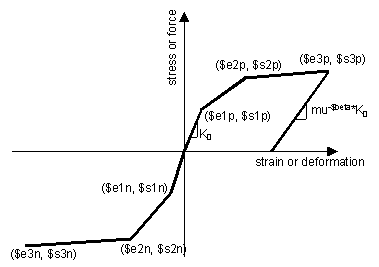Hysteretic Material: Difference between revisions
Jump to navigation
Jump to search
No edit summary |
No edit summary |
||
| (4 intermediate revisions by 3 users not shown) | |||
| Line 4: | Line 4: | ||
{| | {| | ||
| style="background: | | style="background:lime; color:black; width:800px" | '''uniaxialMaterial Hysteretic $matTag $s1p $e1p $s2p $e2p <$s3p $e3p> $s1n $e1n $s2n $e2n <$s3n $e3n> $pinchX $pinchY $damage1 $damage2 <$beta>''' | ||
|} | |} | ||
| Line 37: | Line 37: | ||
[[Image:Hysteretic.gif]] | [[Image:Hysteretic.gif]] | ||
[[Image:Hysteretic2.png]] | |||
| Line 45: | Line 47: | ||
---- | ---- | ||
Code Developed by: <span style="color:blue"> | Examples: | ||
Effects of Hysteretic-Material Parameters [http://opensees.berkeley.edu/OpenSees/manuals/usermanual/4052.htm] | |||
---- | |||
Code Developed by: <span style="color:blue"> Michael Scott (Oregon State University) & Filip Filippou (UC Berkeley) </span> | |||
Images Developed by: <span style="color:blue"> Silvia Mazzoni </span> | Images Developed by: <span style="color:blue"> Silvia Mazzoni </span> | ||
Latest revision as of 22:00, 9 December 2016
- Command_Manual
- Tcl Commands
- Modeling_Commands
- model
- uniaxialMaterial
- ndMaterial
- frictionModel
- section
- geometricTransf
- element
- node
- sp commands
- mp commands
- timeSeries
- pattern
- mass
- block commands
- region
- rayleigh
- Analysis Commands
- Output Commands
- Misc Commands
- DataBase Commands
This command is used to construct a uniaxial bilinear hysteretic material object with pinching of force and deformation, damage due to ductility and energy, and degraded unloading stiffness based on ductility.
| uniaxialMaterial Hysteretic $matTag $s1p $e1p $s2p $e2p <$s3p $e3p> $s1n $e1n $s2n $e2n <$s3n $e3n> $pinchX $pinchY $damage1 $damage2 <$beta> |
| $matTag | integer tag identifying material |
| $s1p $e1p | stress and strain (or force & deformation) at first point of the envelope in the positive direction |
| $s2p $e2p | stress and strain (or force & deformation) at second point of the envelope in the positive direction |
| $s3p $e3p | stress and strain (or force & deformation) at third point of the envelope in the positive direction (optional) |
| $s1n $e1n | stress and strain (or force & deformation) at first point of the envelope in the negative direction |
| $s2n $e2n | stress and strain (or force & deformation) at second point of the envelope in the negative direction |
| $s3n $e3n | stress and strain (or force & deformation) at third point of the envelope in the negative direction (optional) |
| $pinchx | pinching factor for strain (or deformation) during reloading |
| $pinchy | pinching factor for stress (or force) during reloading |
| $damage1 | damage due to ductility: D1(mu-1) |
| $damage2 | damage due to energy: D2(Eii/Eult) |
| $beta | power used to determine the degraded unloading stiffness based on ductility, mu-beta (optional, default=0.0) |
NOTE:
- In cases $s3p > $s2p and abs($s3n) > abs($s2n), the envelope of the hysteretic material after $e3p or $e3n follows the slope defined by 2nd and 3rd point of the envelope.
- In cases $s3p <= $s2p and abs($s3n) <= abs($s2n) the envelope of the hysteretic material after $e3p or $e3n is a flat line with a constant stress (or force) equal to $s3p or $s3n.
Examples:
Effects of Hysteretic-Material Parameters [1]
Code Developed by: Michael Scott (Oregon State University) & Filip Filippou (UC Berkeley)
Images Developed by: Silvia Mazzoni

